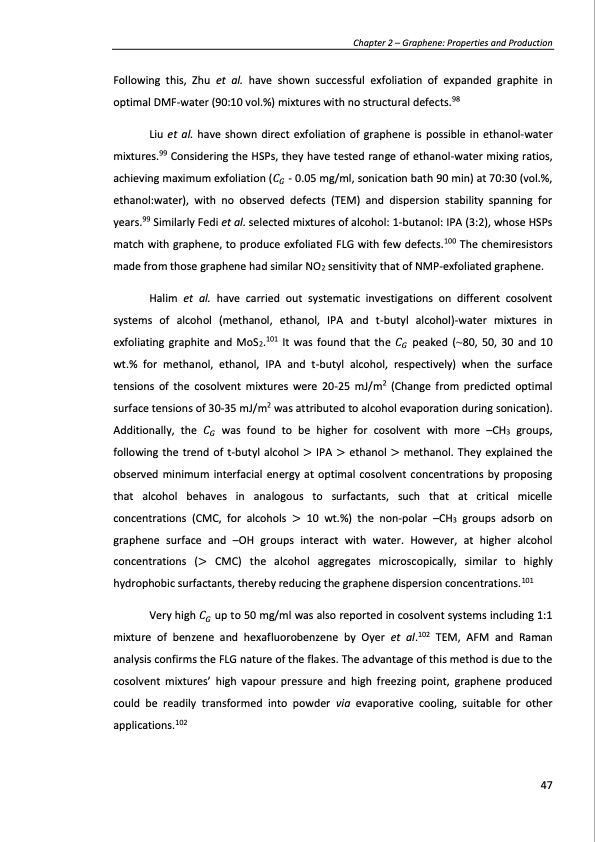PDF Publication Title:
Text from PDF Page: 047
Chapter 2 – Graphene: Properties and Production Following this, Zhu et al. have shown successful exfoliation of expanded graphite in optimal DMF-water (90:10 vol.%) mixtures with no structural defects.98 Liu et al. have shown direct exfoliation of graphene is possible in ethanol-water mixtures.99 Considering the HSPs, they have tested range of ethanol-water mixing ratios, achieving maximum exfoliation (𝐶𝐺 - 0.05 mg/ml, sonication bath 90 min) at 70:30 (vol.%, ethanol:water), with no observed defects (TEM) and dispersion stability spanning for years.99 Similarly Fedi et al. selected mixtures of alcohol: 1-butanol: IPA (3:2), whose HSPs match with graphene, to produce exfoliated FLG with few defects.100 The chemiresistors made from those graphene had similar NO2 sensitivity that of NMP-exfoliated graphene. Halim et al. have carried out systematic investigations on different cosolvent systems of alcohol (methanol, ethanol, IPA and t-butyl alcohol)-water mixtures in exfoliating graphite and MoS2.101 It was found that the 𝐶𝐺 peaked (~80, 50, 30 and 10 wt.% for methanol, ethanol, IPA and t-butyl alcohol, respectively) when the surface tensions of the cosolvent mixtures were 20-25 mJ/m2 (Change from predicted optimal surface tensions of 30-35 mJ/m2 was attributed to alcohol evaporation during sonication). Additionally, the 𝐶𝐺 was found to be higher for cosolvent with more –CH3 groups, following the trend of t-butyl alcohol > IPA > ethanol > methanol. They explained the observed minimum interfacial energy at optimal cosolvent concentrations by proposing that alcohol behaves in analogous to surfactants, such that at critical micelle concentrations (CMC, for alcohols > 10 wt.%) the non-polar –CH3 groups adsorb on graphene surface and –OH groups interact with water. However, at higher alcohol concentrations (> CMC) the alcohol aggregates microscopically, similar to highly hydrophobic surfactants, thereby reducing the graphene dispersion concentrations.101 Very high 𝐶𝐺 up to 50 mg/ml was also reported in cosolvent systems including 1:1 mixture of benzene and hexafluorobenzene by Oyer et al.102 TEM, AFM and Raman analysis confirms the FLG nature of the flakes. The advantage of this method is due to the cosolvent mixtures’ high vapour pressure and high freezing point, graphene produced could be readily transformed into powder via evaporative cooling, suitable for other applications.102 47PDF Image | PRODUCTION AND APPLICATIONS OF GRAPHENE AND ITS COMPOSITES

PDF Search Title:
PRODUCTION AND APPLICATIONS OF GRAPHENE AND ITS COMPOSITESOriginal File Name Searched:
graphene-production-applications.PDFDIY PDF Search: Google It | Yahoo | Bing
Salgenx Redox Flow Battery Technology: Power up your energy storage game with Salgenx Salt Water Battery. With its advanced technology, the flow battery provides reliable, scalable, and sustainable energy storage for utility-scale projects. Upgrade to a Salgenx flow battery today and take control of your energy future.
CONTACT TEL: 608-238-6001 Email: greg@infinityturbine.com (Standard Web Page)